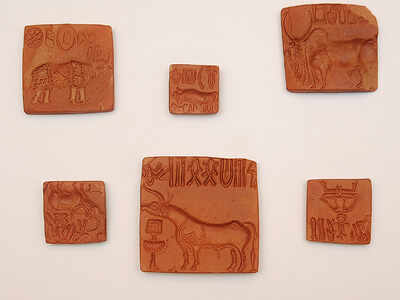- News
- India News
- Why we still can’t crack the Indus script
Trending
This story is from February 8, 2020
Why we still can’t crack the Indus script

Replicas of Harappan seals that show the yet undeciphered script (File photo)
NEW DELHI: While presenting the budget recently, Finance minister Nirmala Sitharaman referred to the Indus Valley Civilisation and claimed that the Indus script has been deciphered, which has put the spotlight on this enigmatic 4,000-year-old script that has foxed scientists, linguists, archaeologists and others. The task is so daunting that a $10,000 award for deciphering it announced in 2004 remains unclaimed.
Harappa, the first city of the Indus Valley Civilisation that was discovered, was excavated in 1920-21.But a century later, why has no serious researcher deciphered the script? There have been multiple claims but none of them have held up. In fact, there is strong disagreement among linguists and Indologists about the very nature of the script. Indologist Prof Michael Witzel of Harvard University and others had claimed in 2004 that the Indus script may not have been linguistic at all, while Prof Asko Parpola, professor emeritus, University of Helsinki, Finland, who has been trying to decipher the script since 1968, and others say it was pretty much linguistic and may have belonged to the Dravidian family of languages.
Nevertheless, the problems with the deciphering of the script are manifold. Witzel lists two main reasons: “We do not know which language(s) was spoken in the Indus civilisation. Also, we do not know the value (linguistically or not) of the Indus signs. Some of them seem obvious, such as: a certain seed, a plough, etc. But what about the squirrel on a tree, or the duck in a pond? All attempts so far do not lead anywhere.”
Dr Nisha Yadav of Tata Institute of Fundamental Research, Mumbai, adds to the list of problems. “Extreme brevity of the Indus texts (average text length is about five signs), absence of bilingual or multilingual texts, and apparent discontinuity in traditions at the decline of the Indus Valley Civilisation are the other problems.” Bilingual and multilingual texts are those where a text is placed alongside one or more translations.
Parpola still stands by his hypothesis. “In my opinion, the Harappan language belonged to the Dravidian family (which is today represented by Tamil, Malayalam, Kannada, Telugu and some 20 tribal languages), and the Indus script can be deciphered without bilinguals to a limited extent.”
In the absence of a bilingual text, like the Rosetta Stone which helped in deciphering Egyptian hieroglyphs, Indus script researchers say the going ahead is difficult. But Yadav still has hope. “Ancient scripts such as Linear B (earliest Greek script) have been deciphered earlier without bilingual texts as well.”
Harappa, the first city of the Indus Valley Civilisation that was discovered, was excavated in 1920-21.But a century later, why has no serious researcher deciphered the script? There have been multiple claims but none of them have held up. In fact, there is strong disagreement among linguists and Indologists about the very nature of the script. Indologist Prof Michael Witzel of Harvard University and others had claimed in 2004 that the Indus script may not have been linguistic at all, while Prof Asko Parpola, professor emeritus, University of Helsinki, Finland, who has been trying to decipher the script since 1968, and others say it was pretty much linguistic and may have belonged to the Dravidian family of languages.
Nevertheless, the problems with the deciphering of the script are manifold. Witzel lists two main reasons: “We do not know which language(s) was spoken in the Indus civilisation. Also, we do not know the value (linguistically or not) of the Indus signs. Some of them seem obvious, such as: a certain seed, a plough, etc. But what about the squirrel on a tree, or the duck in a pond? All attempts so far do not lead anywhere.”
Dr Nisha Yadav of Tata Institute of Fundamental Research, Mumbai, adds to the list of problems. “Extreme brevity of the Indus texts (average text length is about five signs), absence of bilingual or multilingual texts, and apparent discontinuity in traditions at the decline of the Indus Valley Civilisation are the other problems.” Bilingual and multilingual texts are those where a text is placed alongside one or more translations.
Yadav co-authored a paper in 2009 which had, using a computer programme, provided evidence in favour of the linguistic hypothesis of the Indus script. “Our studies suggest that the Indus script had a rich syntax with an underlying logic in its structure. Linearity, directionality, use of certain modifying elements in its sign designs, diverse usage of the script, and its use in foreign lands (at West Asian sites with some rare combinations of signs), are some of the other characteristics of the Indus script that tilt the evidence in favour of the linguistic hypothesis,” Yadav says.
Parpola still stands by his hypothesis. “In my opinion, the Harappan language belonged to the Dravidian family (which is today represented by Tamil, Malayalam, Kannada, Telugu and some 20 tribal languages), and the Indus script can be deciphered without bilinguals to a limited extent.”
In the absence of a bilingual text, like the Rosetta Stone which helped in deciphering Egyptian hieroglyphs, Indus script researchers say the going ahead is difficult. But Yadav still has hope. “Ancient scripts such as Linear B (earliest Greek script) have been deciphered earlier without bilingual texts as well.”
End of Article
FOLLOW US ON SOCIAL MEDIA










